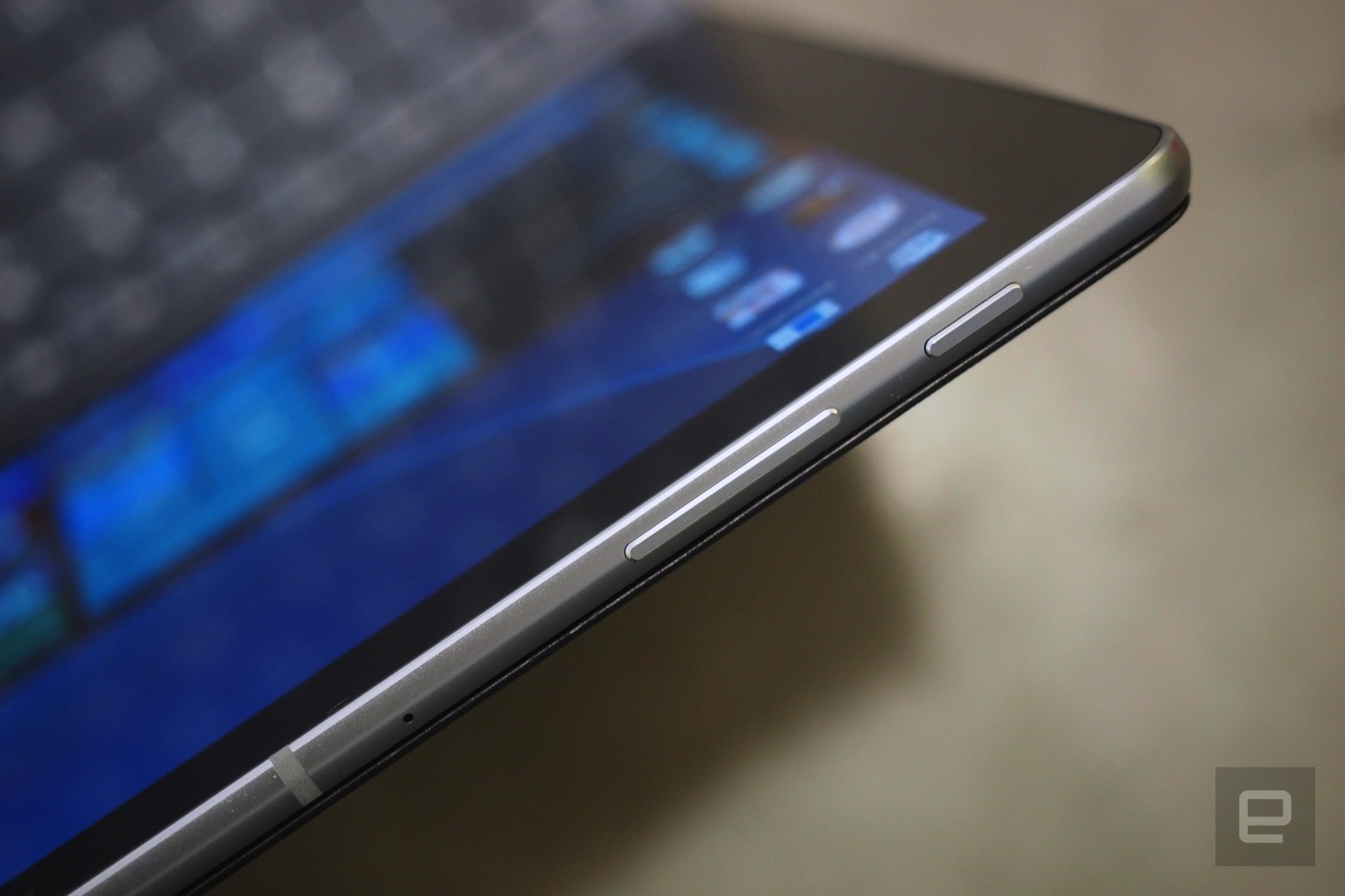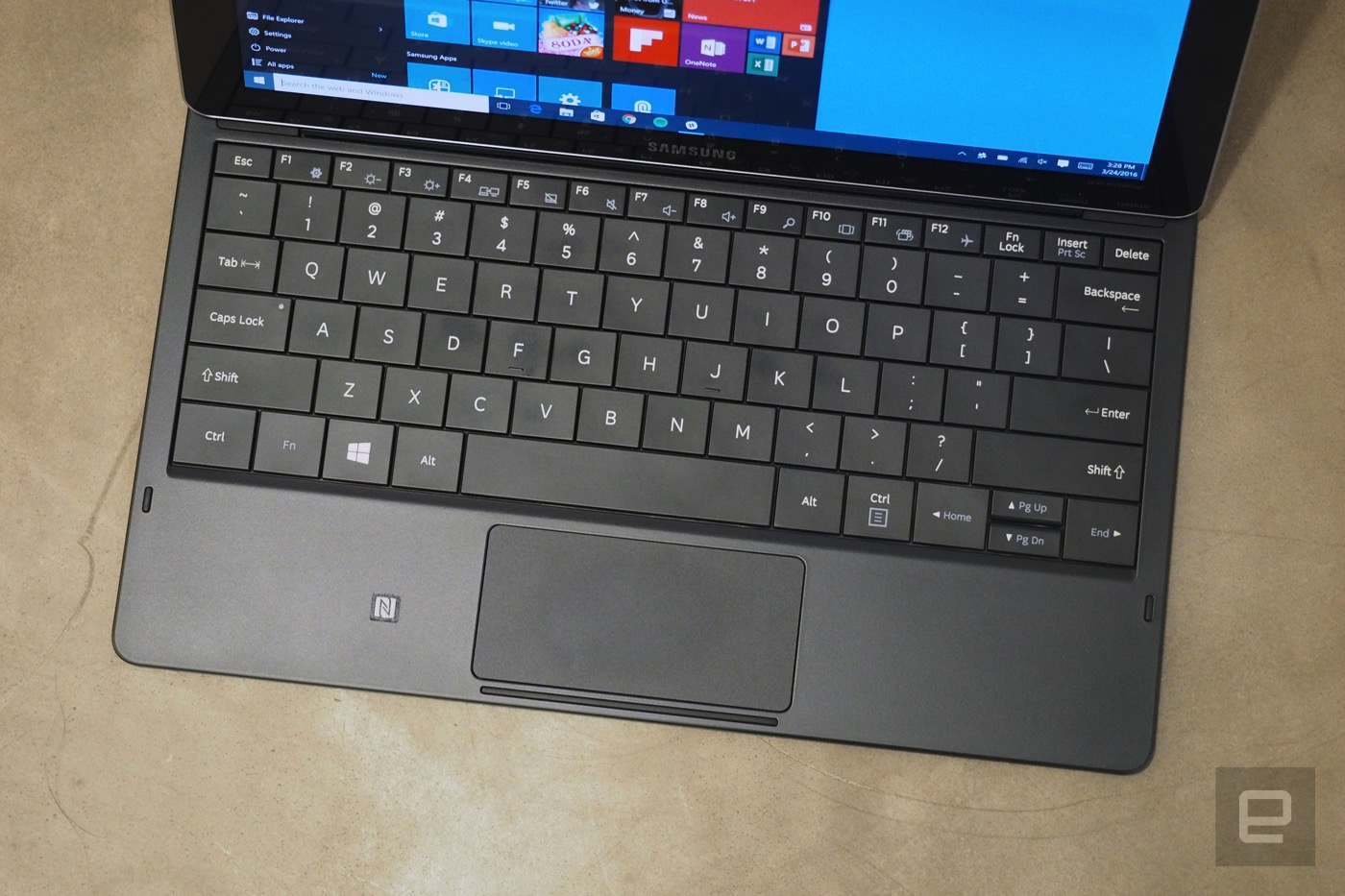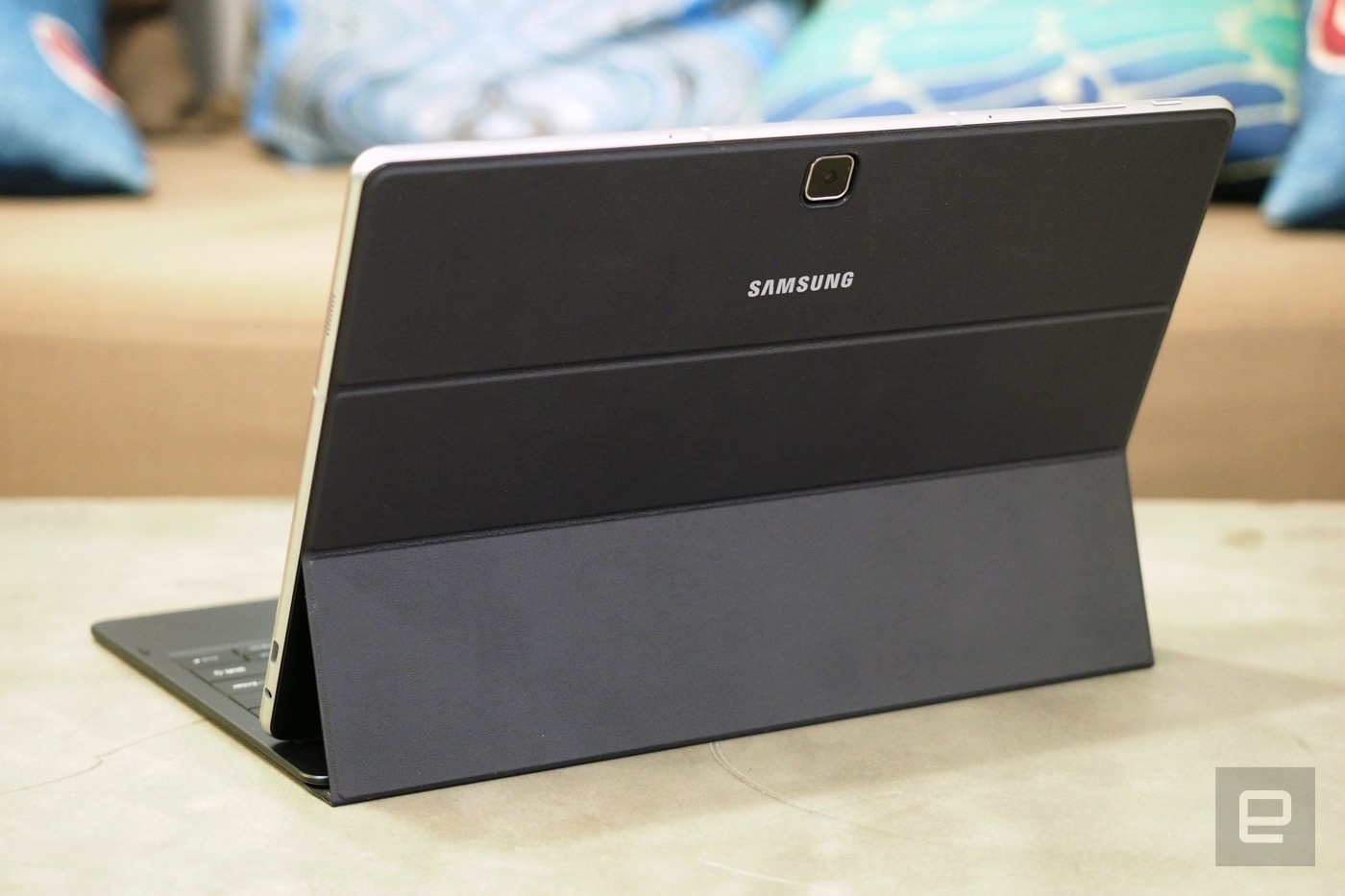You get the same "Pro" power, but in a smaller, sleeker body.
The iPad Pro raised some eyebrows when it debuted last year, but it really shouldn't have. Although tablet sales as a whole have been tanking, sales of tablets with detachable keyboards have actually grown. Is it any surprise, then, that Apple built a 9.7-inch version of the Pro to try and regain some of its tablet momentum? Not at all. Whether or not this new Pro can be the "ultimate PC replacement" Apple was hyping at its launch event depends on your personal preferences, but let's get one thing straight from the start: This is one the best tablets you can buy.
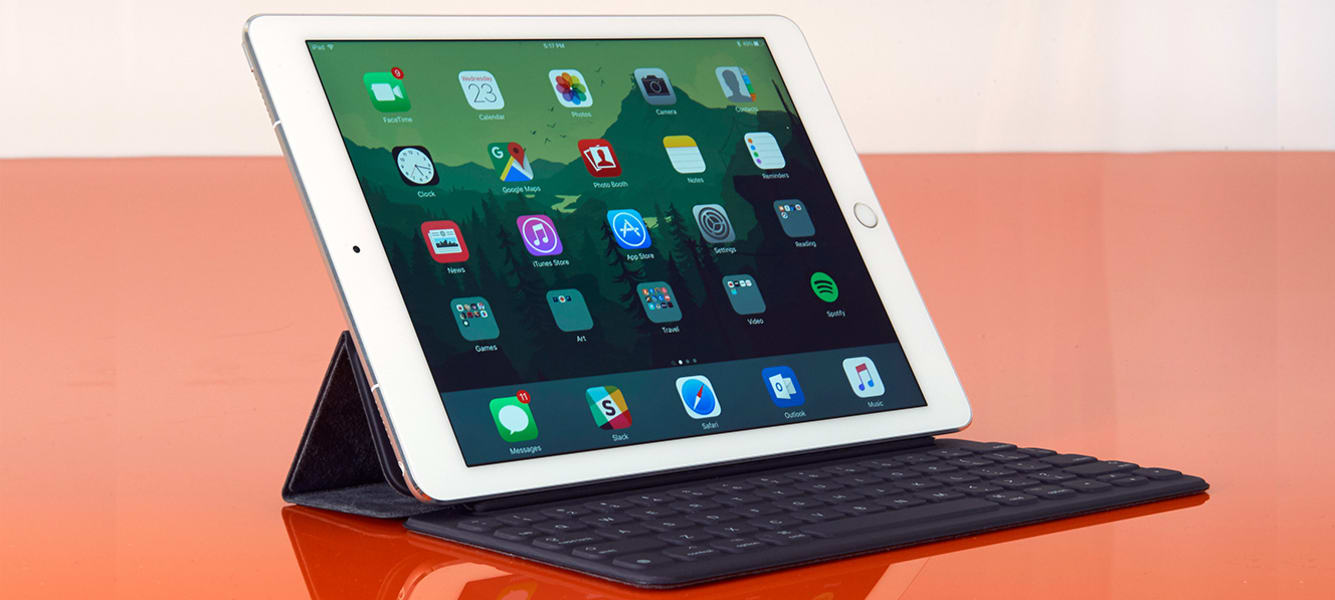
Pros
Fantastic screen
Slim design with excellent build quality
Strong performance
Best iPad camera yet
Cons
iOS still isn't great at multitasking
Only has half the RAM of the larger model
Optional keyboard is cramped
Summary
Calling it a full-blown laptop replacement is a stretch, but Apple's new 9.7-inch iPad Pro is the best conventional tablet the company has made. It combines the power of the original 12.9-inch iPad Pro with the thin frame of the iPad Air 2. Additionally, it brings a vibrant, color-accurate screen and the best camera we've seen on an iPad to date. If you need a proper laptop, you should still buy one, but if all you want is a great tablet, the 9.7-inch Pro is the one to get.
Cons
iOS still isn't great at multitasking
Only has half the RAM of the larger model
Optional keyboard is cramped
Summary
Calling it a full-blown laptop replacement is a stretch, but Apple's new 9.7-inch iPad Pro is the best conventional tablet the company has made. It combines the power of the original 12.9-inch iPad Pro with the thin frame of the iPad Air 2. Additionally, it brings a vibrant, color-accurate screen and the best camera we've seen on an iPad to date. If you need a proper laptop, you should still buy one, but if all you want is a great tablet, the 9.7-inch Pro is the one to get.
Hardware
Tell me if this sounds familiar: Apple, looking to broaden its appeal, takes an existing high-end device and squeezes its important bits into a smaller, familiar-looking body. That was the case with the iPhone SE, and at first glance, that appears to be true of the 9.7-inch iPad Pro as well; it seems like last year's iPad Pro in the body of an iPad Air 2. Still, there are some omissions to be aware of. The A9X chipset in the 9.7-inch model is back, for instance, but it's paired with 2GB of RAM -- half of what the larger model has. I'll dig into what that means for performance a little later (spoiler: not much for most people), but the change nonetheless makes this Pro seem, well, a little less Pro. 3D Touch still hasn't made it over to the iPads, either because of cost or sheer technical infeasibility. There's a Touch ID sensor embedded in the Home button as usual, but it seems to be the slightly slower, older version, not the one in the iPhone 6s. Oh well.
Your mileage may vary, but the tradeoffs seem well worth it to me. It's been a week since Apple loaned me a review unit (a silver LTE model with 256GB of storage, priced at $1,029), and I'm still impressed with its fit and finish. The physical differences between this model and the Air 2 are nearly non-existent, which raises an interesting conundrum -- at first, this thing doesn't feel any more Pro than the Air 2 because they share a frame.

Then again, I'm not the kind of person who's eager to trade a traditional laptop for a tablet. Full disclosure: I've been an outspoken fan of the Air 2's design since it came out, but using the super-snappy Pro ruined that older tablet for me. Now nearly all that power is available in a more manageable size, albeit one that feels less like a full-blown PC replacement. After all, the big Pro's 12.9-inch screen was great for movies and certain professional applications (as was that extra RAM).
The rest of the new Pro's broad strokes are the same as its big brother's: There's a power button up top, four speakers drilled into each corner and the same three-pin Smart Connector on the left side for accessories. Apple couldn't downsize the massive 38.5Wh battery to fit in the Air 2-sized chassis, though, so we're left with a smaller 27.5Wh battery instead.
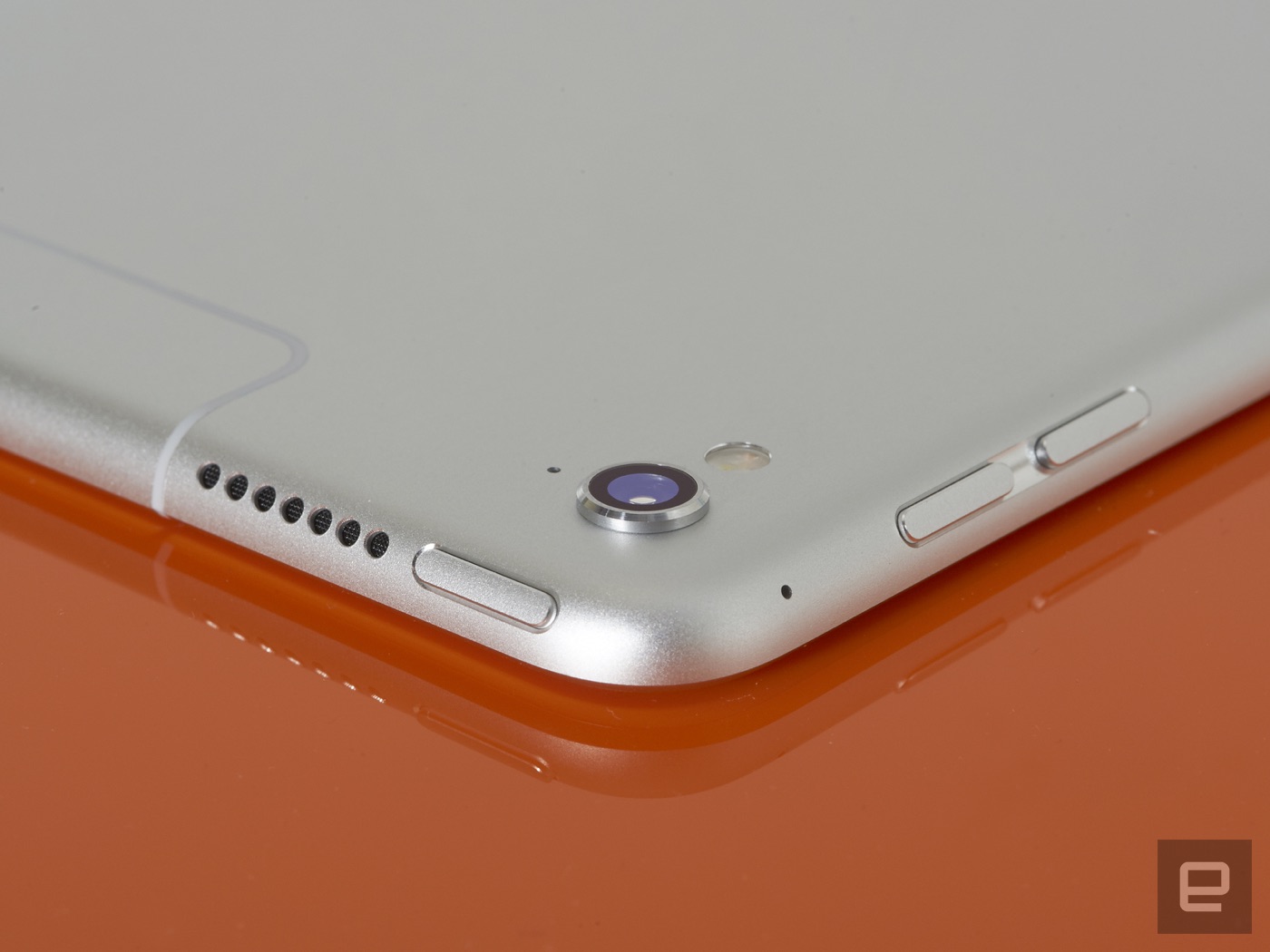
Curiously, the 9.7-inch model is in some ways more impressive than the original. For starters, it features the iPhone 6s's 12-megapixel rear camera with a f/2.2 lens (tourists, rejoice!). I won't dwell on it since I've basically reviewed the same camera sensor three times now; suffice to say, it's the best camera ever put in an iPad and you'll be able to capture some primo shots—if tablet photography is your thing. Oh, and the plastic panel on the back of 3G models has been replaced with an iPhone-like antenna band, too. Now it's time for some nitpicking: The antenna band carved into the LTE Pro's aluminum body isn't completely even, and I can't un-see it. On the plus side, the camera lump on the back doesn't make the iPad wobble when it's resting face-up on a table -- iPhone 6s owners can't say the same.
All this power might cost you, though. The Pro starts at $599 for the 32GB WiFi model, with 128GB and 256GB versions costing an extra $150 and $300, respectively. And as always, cellular-ready options will cost you even more: a $130 premium across the board.
Display and sound
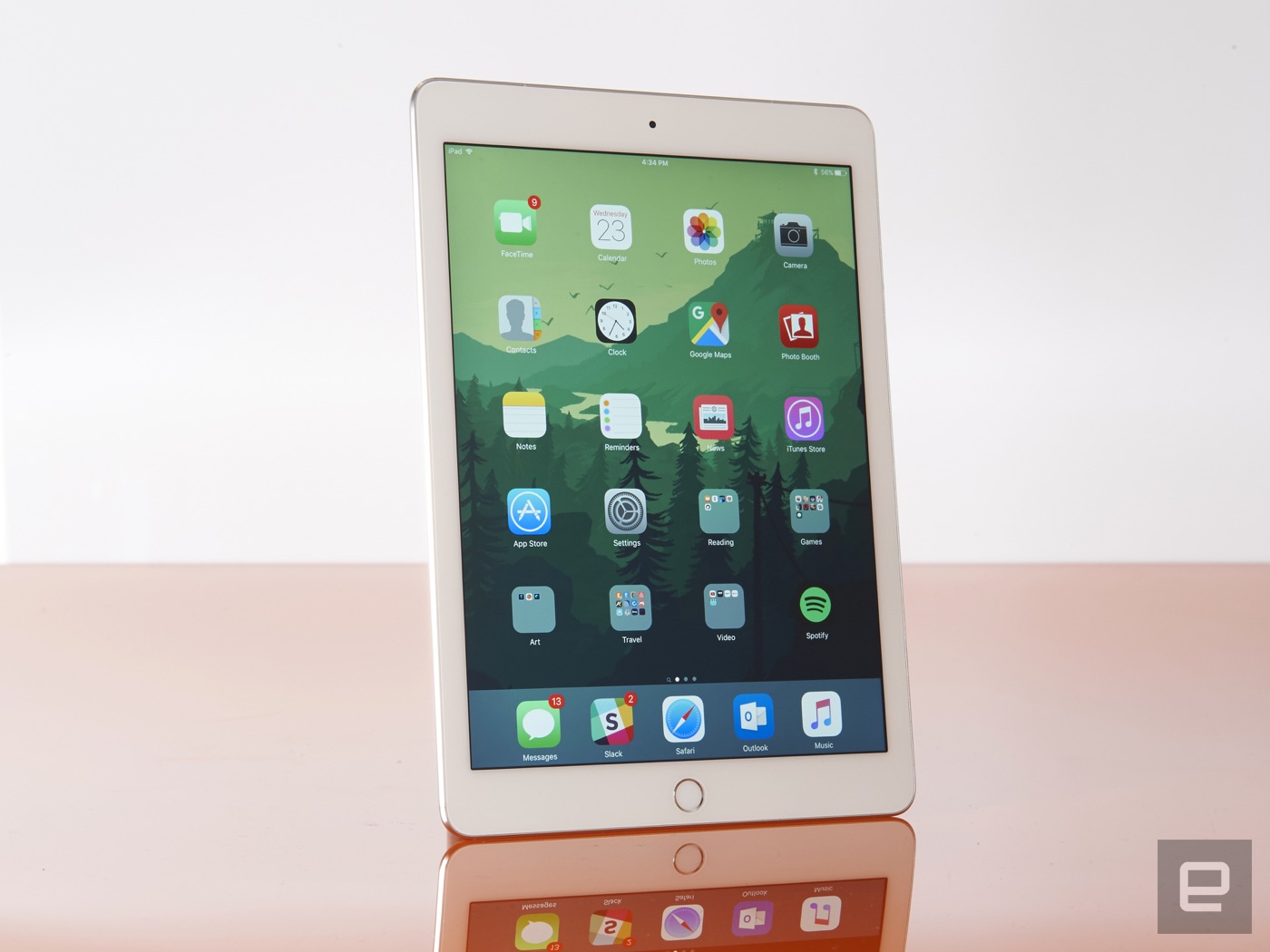
Now, about that screen. It's fantastic. The 9.7-inch LED display runs at a resolution of 2,048 x 1,536, so it's not any crisper than the Air 2 or original Pro, but whatever: It's still sharp and beautifully saturated. Videographers and editors in particular will appreciate Apple's support for the P3 color gamut, a standard with a broader range of colors that sees wide use in the film industry. The feature first debuted on the recent 4K and 5K iMacs and could be quite valuable for some -- after all, the Pro offers enough power to ingest and edit three 4K video streams at the same time. Then again, if you're an amateur like me, you'll likely never need to know these specifics.
The screen is very bright too -- actually a hair brighter than the first iPad Pro (the difference is 100 nits, if you're keeping count). The difference might not be vast, but if nothing else, it makes for a display that's easy to read in direct sunlight. The sun's only going to get more intense as spring wears on, but I was able to breeze through a few chapters of a Rafik Schami novel while lounging in my backyard. Reading, as it turns out, is a great way to test one of the new Pro's unique features, the True Tone display. In short, it uses an ambient sensor stuck in the iPad's forehead to figure out what kind of light you're in and change the screen's color temperature to look more natural.

It might sound like one of those uber-nerd features you'll never use, but it's actually lovely. See, the iPad's display is normally neutral to the point of looking slightly bluish. True Tone automatically adjusts the color so that whites look like a sheet of paper no matter what weirdly lit environment you're in. This might sound a little familiar: Samsung's Galaxy Tab S did this too years back, but it's a neat feature nonetheless. True Tone doesn't seem to have much of an impact on battery life either, so the only reason not to use it is if you're editing photos or cutting video -- situations where you really need that color accuracy.
Meanwhile, the speakers are just as loud as they were on the original Pro. If you haven't used the larger model, take it from me: This is a good thing. Speaker design aside, we've also got some clever software to thank for this. As on the first iPad Pro, no matter which way you're holding the iPad, highs and mids get routed to the top-most speakers, while lower frequencies issue forth from the bottom pair. The end result is crisp sound whether you're listening to audiobooks or the amazing finale fromWhiplash.
Performance and battery life
| IPAD PRO 9.7 | IPAD PRO 12.9 | IPAD AIR 2 | |
|---|---|---|---|
| Geekbench 3.0 Multi-core | 5,235 | 5,379 | 4,510 |
| 3DMark IS Unlimited | 33,403 | 32,544 | 21,659 |
| GFXBench 3.0 Manhattan Off/onscreen (fps) | 51.2/34.9 | 79.3/33.6 | 13.0/8.8 |
| SunSpider 1.0 (ms) | 199 | 191 | 393 |
| Google Octane 2.0 | 19,946 | 19,872 | 10,659 |
| Mozilla Kraken (ms) | 1,512 | 1,499 | 2,332 |
| JetStream 1.1 | 139 | 141 | 83 |
I'll admit it, I was pretty curious coming into this review. After all, this iPad Pro has half the RAM the other Pro does, but then again, it's driving a much smaller display (and therefore needs to push fewer pixels). As it turns out, I was concerned over nothing. Thanks to Apple's A9X chipset, the 9.7-inch Pro is almost equally fast.
I spent my week putting the Pro through a wide (and weird) variety of scenarios. It was well-suited to shooting off Slack messages and Outlook emails during workdays, as well as light photo editing in Pixelmator and incessant Tweetbot refreshes. Basic actions like switching between apps and using iOS 9's Slide Over feature to run two apps in split-screen felt smooth too. I expected multitasking in particular to be a little jerkier because of the smaller RAM allotment, but nope: All was well.
Of course, the Pro line prides itself on running specialized, power-intensive apps, and those posed no problem here either. I blew an entire evening spinning a meticulously rendered skeleton around to learn the names of bones and trying (in vain) to design something worth showing off in 3D design apps like UMake and Autodesk's Formit 360. (Sorry mom, I'll never be that architect you wanted.) When my misguided attempts at creativity failed, I threw myself into gorgeous games like AG Drive andWarhammer 40,000: Freeblade. Surprise, surprise: Both of them (and many others) ran smoothly.
Now, I didn't see any differences in graphical and gaming performance between the two iPad Pros, but that doesn't mean there aren't any. The Pro 9.7 notched near-identical benchmark scores as the bigger model, except for some strangely low frame rates when I ran GFXBench's off-screen Manhattan test. (Both Pros delivered near-identical numbers when rendering frames on-screen.) That hiccup aside, this is the most power Apple has ever crammed into a 9.7-inch iPad, and if you're coming from an older iPad, it's downright revelatory.
The iPad Pro 9.7 ships with iOS 9.3, and aside from a few notable additions like Night Shift and a more secure Notes app, the software experience is nearly identical to the original Pro. Sadly, that means multitasking can feel clumsy and inelegant -- not quite what I hoped for out of a device Apple claims can replace a traditional laptop. Swiping on the screen to open the app drawer (where you can choose an app to run in "Split View" mode) reveals an unorganized list that often requires some poking around to find the app you were looking for.
And when you're split-screening, it takes to work to change how those two apps are displayed. Let's say you've got Safari running on the left side and Mail on the right: To make them switch places, you have to drag the divider to make Mail full-screen and open up Safari from the Slide Over panel. Nightmare? Hardly, but it's still more tedious than it should be. Then again, this is the sort of interface issue that affects power users and PC switchers more than anybody else; if you're just looking for a speedy tablet, you might not care at all.
BATTERY LIFE
| |
|---|---|
| iPad Pro 9.7 | 9:21 |
| iPad Pro 12.9 | 10:47 |
| iPad mini 4 | 13:04 |
| iPad Air 2 | 11:15 |
| Galaxy TabPro S | 10:43 |
| Lenovo Yoga 3 Pro | 7:36 |
| Surface Pro 4 | 7:15 |
Apple likes to say that each of its iPads can last through "up to 10 hours" of continuous use, and each of the last three iPads we tested easily exceeded that mark in our battery rundown test (looping an HD video with screen brightness set to 50 percent). The 9.7-inch Pro sadly didn't fare quite as well: It lasted for nine hours and 21 minutes before giving up the ghost. I'll admit, I was a little disappointed that it didn't do better, but I also can't fault Apple for "only" delivering what it promised. Managing expectations can be tricky, folks.
Not everyone uses their tablets for daily Netflix marathons, though. The 9.7-inch Pro hung around for between three and four days of mixed use. Think: firing off emails, watching YouTube videos, streaming podcasts and more, mixed with long stretches of idle time. This sort of off-and-on usage more accurately reflects the way most people use their tablets, and in that regard, the iPad Pro does a fine job.
Accessories

The iPad Pro formula extends beyond just the tablet: It includes some first-party accessories too. First up is the $99 Apple Pencil, which is as useful as always. I did a lot of doodling in notebooks growing up and even tried my hand at drawing webcomics (which you will never, ever see). Using the Pencil to sketch in Procreate and even the stock Notes app is a surprisingly lovely experience; the screen does a great job tracking the Pencil's textured nib, and pressing harder to get bolder lines works way better than I expected it would. If anything, I enjoyed using the Pencil more with the smaller Pro because the tablet is closer in size to a clipboard, making it better for one-handed note-jotting.
Then there's the new, smaller Smart Keyboard cover ($149). I tried writing this review using the keyboard just to prove a point, and man, I just couldn't do it. Mechanically, there's no difference between this version and the bigger one meant for the full-size Pro; the whole thing is covered in a custom fabric is both liquid-repellant and gives the keys their shape. Since iOS doesn't support mice, there's no trackpad here either, so you'll frequently be reaching to tap the screen.
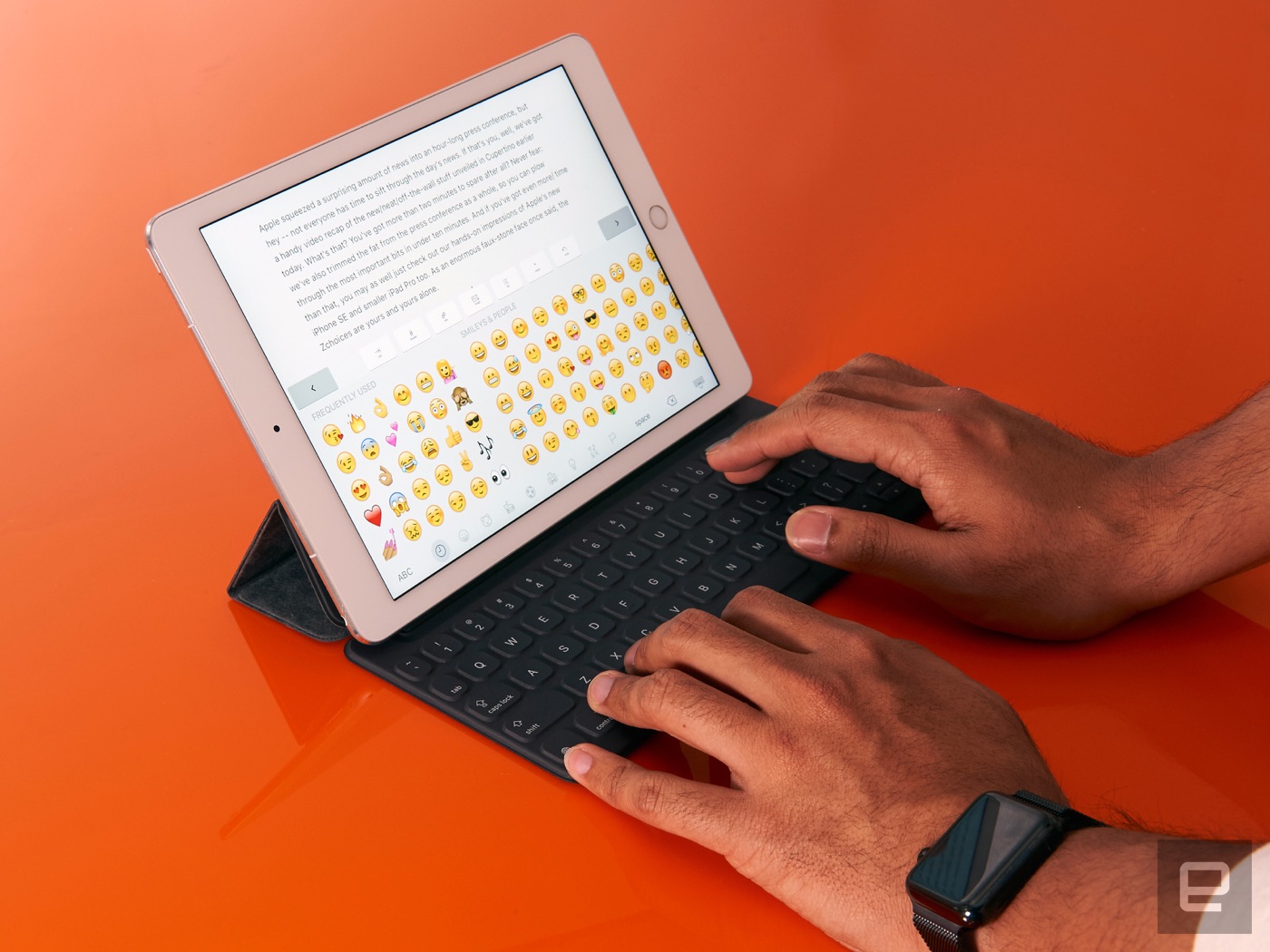
The problem is, the keyboard itself can feel pretty cramped if you're used to anything more spacious. Notably, the Return and Tab keys are much smaller than on the big Pro's keyboard, making it frustrating to navigate and format some documents. I eventually got half-decent at pecking out short stories, but using it for anything longer than that can be tricky. The keyboard cover only props up the iPad at one angle, so you're out of luck if you need to adjust it. If you don't mind looking a little silly, though, you can attach the Smart Keyboard meant for the full-sized Pro onto the baby model and peck out memos no problem. In fact, that's how I wrote the majority of this review. While there aren't any keyboard alternatives that run into Apple's Smart Connector, that'll change soon (and they'll probably cost less too).
The competition

At the company's recent keynote event, Apple's Phil Schiller kept calling the iPad Pro the "ultimate PC replacement," but that honestly seems like a stretch for most people. That's why I'm not lumping the new Pro in with typical flagship laptops. Between its smaller screen and thin build, I suspect people are more likely to use it as a normal tablet than a full-on productivity machine.
Anyway, if you're considering buying this, there are two obvious alternatives you'll need to consider: the 12.9-inch Pro and the iPad Air 2. Apple dropped the price of the 16GB Air 2 to $399 to serve as the company's entry-level big iPad, but really, if you're scrimping for a roughly 10-inch tablet, you're better off paying the extra $200 to get a 32GB iPad Pro 9.7. The better screen and improved horsepower are worth it. Meanwhile, there really isn't a functional power difference between the two iPad Pro versions: The bigger model ($799-plus) is the better bet if you really want to use an iOS device as a workhorse, but you'll probably need to buy some accessories to complete the effect.
You could also consider something like Google's Pixel C: It's a well-built tablet that also doubles as a faux-laptop with a surprisingly nice little keyboard add-on. The base 32GB model will set you back $499 -- $100 less than the base iPad Pro 9.7 -- but Google needs to do a better job getting developers to craft thoughtful, well-designed tablet apps. There's no split-screen multitasking in Android Marshmallow, though that won't be a problem for too much longer; Android N includes that feature and it seems to work well even on phones like the Nexus 5.
And of course, there's the Windows side to look at too. Microsoft's Surface Pro 4 starts at $899 but comes with more storage, its own pressure-sensing pen and an OS that can run crucial legacy desktop apps in addition to touch-optimized ones. In short, the Surface Pro 4 is a Windows laptop with the body of a tablet. The iPad Pro 9.7, meanwhile, is a tablet that only aspires to be as versatile as a PC.
Wrap-up
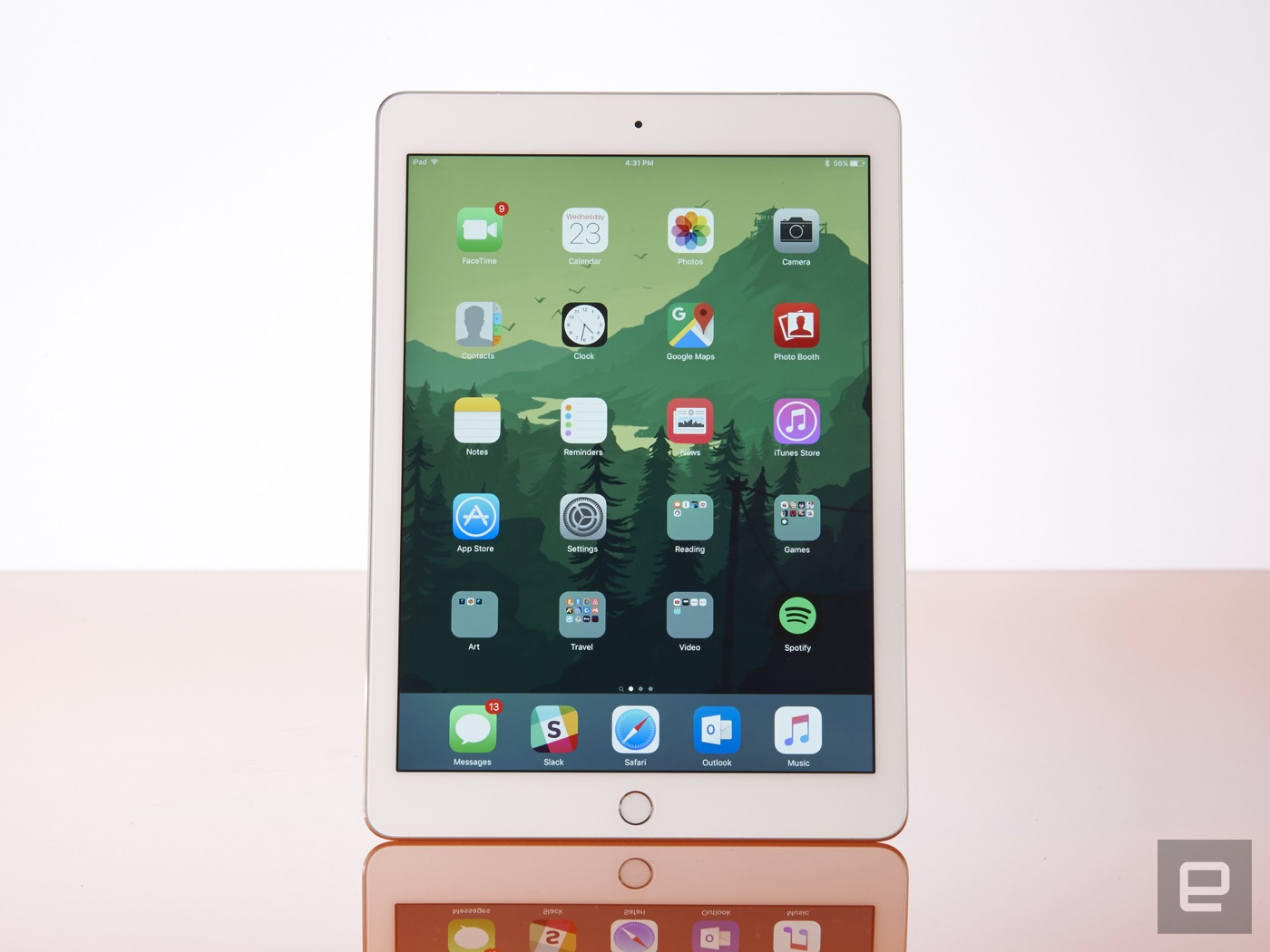
As I've been working through this review process, I've been struggling with one question: What, beyond just marketing, makes this iPad a Pro? Don't get me wrong, the 9.7-inch Pro is easily the best conventionally sized tablet Apple has ever made, but its size makes it tougher to use as an "ultimate PC replacement." In the end, though, the "Pro" distinction might prove to be meaningless. If you're looking for a new tablet, you'd miss out if you didn't at least consider this thing. It's just a fantastic little machine.





